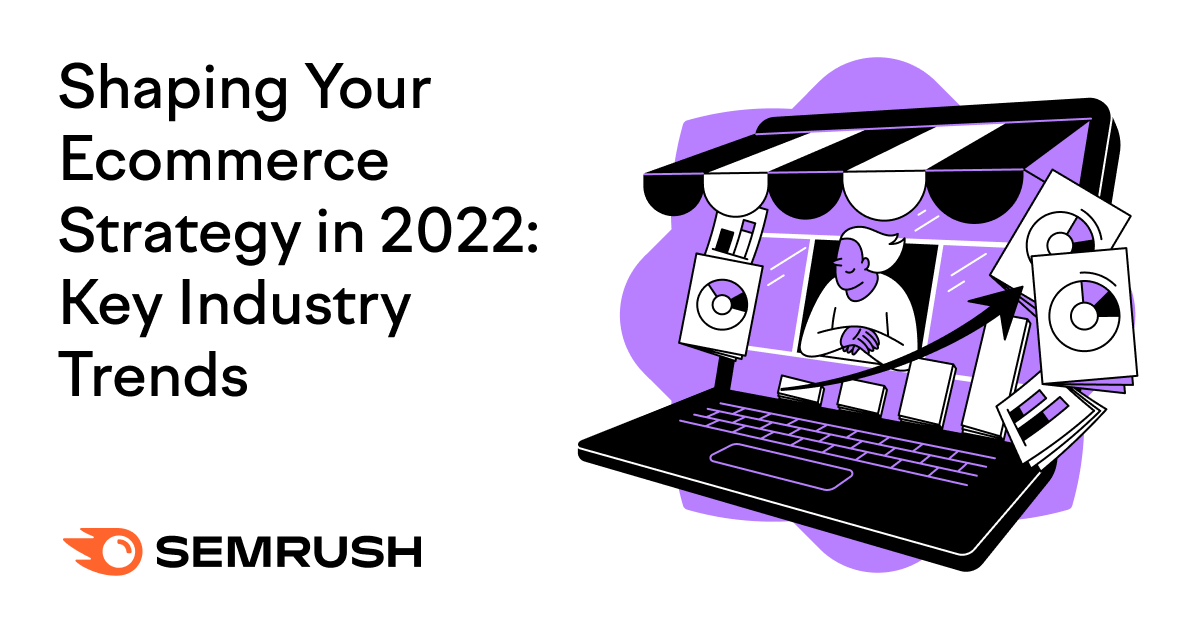The global ecommerce market has experienced unprecedented growth since the start of the pandemic. The so-called “pandemic effect” generated large spikes in online shoppers, and especially first-timers, as well as the accelerated arrival of newer ecommerce business formats like online grocery shopping and last-mile deliveries.
While the ecommerce boom continued through 2020, the world has adapted in many ways. We’re seeing softer restrictions to offline experiences, and continued disruptions to the global supply chain and output. Have these issues impacted the increasing appeal of online shopping? What trends have vanished into thin air, and which ones are here with us to stay?
This report uses insights from the Semrush .Trends platform to address these questions. We assess the depth of the ecommerce boom in 2021 and highlight some ecommerce trends that are here to stay—all to help you shape a smarter, insight-driven digital marketing strategy for your ecommerce business in years to come.
Ecommerce Industry’s Global Trends and Shifts: Traffic Slowdown, Diverse Geo, and…?

In dollars, the ecommerce industry has seen double-digit growth rates for the past decade. Traffic-wise, we’ve seen a similar pattern—shoppers are increasingly moving to online platforms to look up products for purchase.
COVID only fueled this trend. Year-over-year (YoY) traffic trends across the entire industry shows that from 2019 to 2020, e-tailers saw 27% more traffic. If we look at the hottest months for ecommerce—namely, pre- and winter holiday months—the November 2020 traffic reached an all-time high.
But has this growth trend continued in 2021? Traffic data shows that while interest in online shopping platforms remains high, it hasn’t grown. To the contrary, it looks like shoppers’ online craze cooled down—if we stack Q3 2020 stats up against the Q3 2021 numbers, we can see that 2021 ecommerce traffic went down by 2%.
What does this mean: As an ecommerce business, you can no longer just rely on the expanding market to capitalize on the overall growth. As the market stops growing, you should refocus your marketing strategy to market share expansion.
Online Shoppers’ User Behavior Shifts
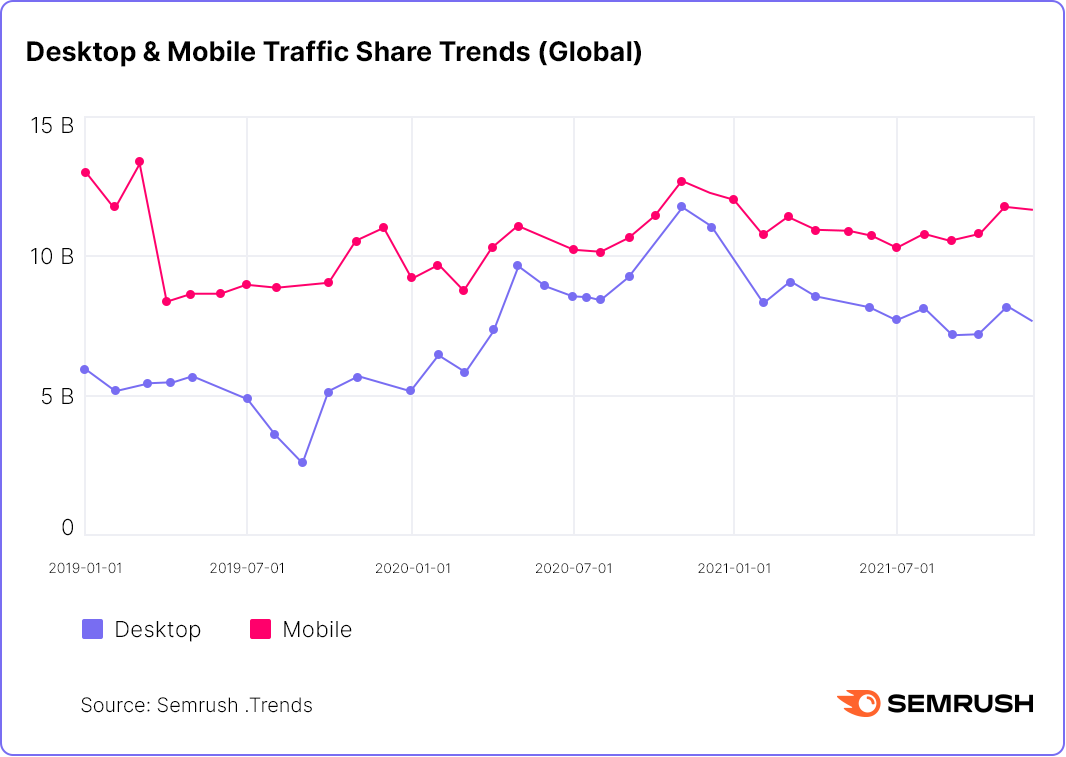
When it comes to user behavior changes, the pandemic was marked by an overwhelming increase in desktop usage. As more people stayed at home, on-the-go web surfing became less popular, so a lot of users turned to good old desktops whenever they needed to look up something online.
Has this affected the device breakdown within ecommerce, though?
As of 2021, mobile traffic still dominates the ecommerce industry, with more than 56% of online shoppers still surfing ecommerce sites from their phones.
Yet ever since the start of the pandemic, desktop usage has grown, and during November 2020, mobile-desktop breakdown did come extremely close. After that—just as the world was slowly rolling back on some pandemic restrictions—the gap widened once again.
Still, desktop’s growth appears to have stuck for the long haul, and today’s desktop traffic exceeds that of pre-pandemic by around 60%.
What does this mean:While we do all operate now in the mobile-first era and mobile experiences are still the priority, don’t disregard desktop completely. In ecommerce, desktop traffic share is comparable to that of mobile, so you have to tailor to both mobile and desktop users and provide an impeccable cross-device experience.
What Countries Are Online Shoppers Coming From?
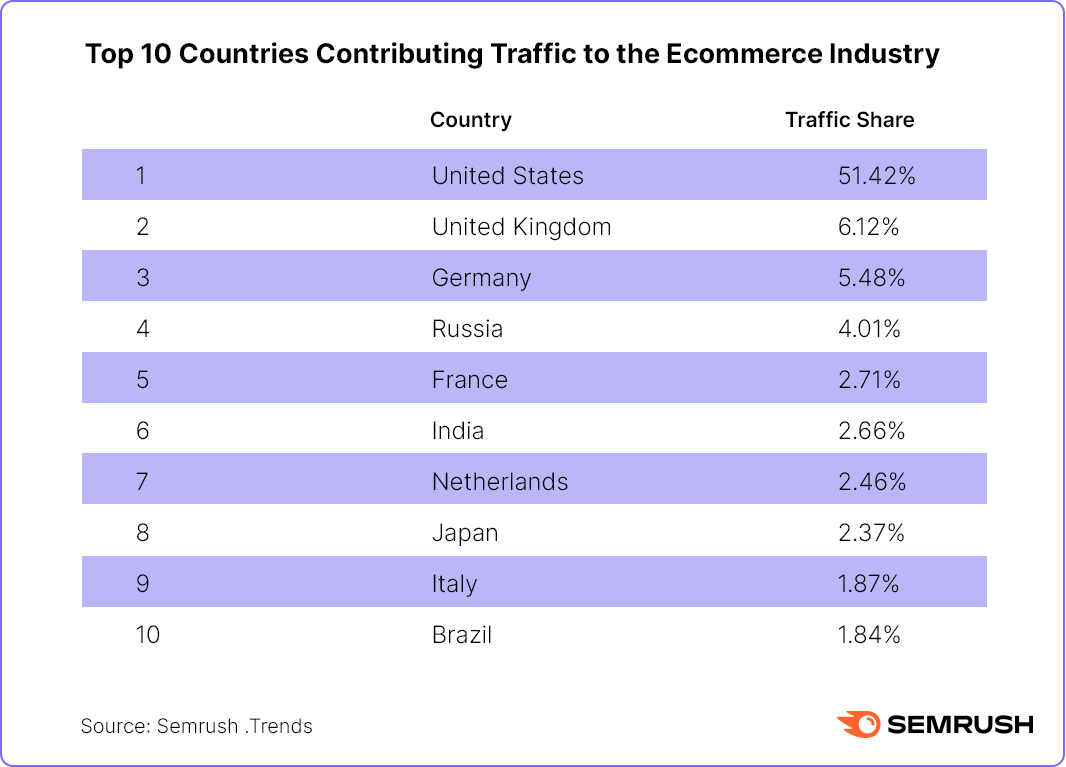
The ecommerce boom has taken over the entire world. But as you’d expect, it’s the countries with some of the highest GDP across the globe that bring in the most traffic to ecommerce sites.
The US, the UK, and Germany top the list of countries bringing the largest shares of online shoppers. The rest of the list also makes sense, with the top 10 here almost perfectly synchronized with the top 10 countries by GDP.
What does this mean: The English-speaking world absolutely dominates the ecommerce landscape. Yet when thinking about growing your market share, you might want to consider other markets like France, Germany, and Japan and translate your website (or like Amazon, actually have a separate site) for non-English-speaking visitors.
Top Ecommerce Market Players (Global)

When it comes to top ecommerce players, US-based businesses make up the majority. Amazon, eBay, and Walmart have the largest traffic share with the latter showing a growth rate of 21%, the highest of 2021.
While Asian companies are definitely a force to reckon with, as Asia (and especially China) has some of the most digital-first population, the China-based Aliexpress saw the biggest -19% YoY traffic drop—we can ‘blame’ the supply chain or smarter marketing tactics of other players, but the pattern is here.
Curiously, just as we saw in our country-by-country traffic breakdown, Germany shows a lot of promising signs. Its local Amazon website has the fifth largest market share among the ecommerce industry, and it shows the second-fastest growth trends.
Top Ecommerce Players by Region
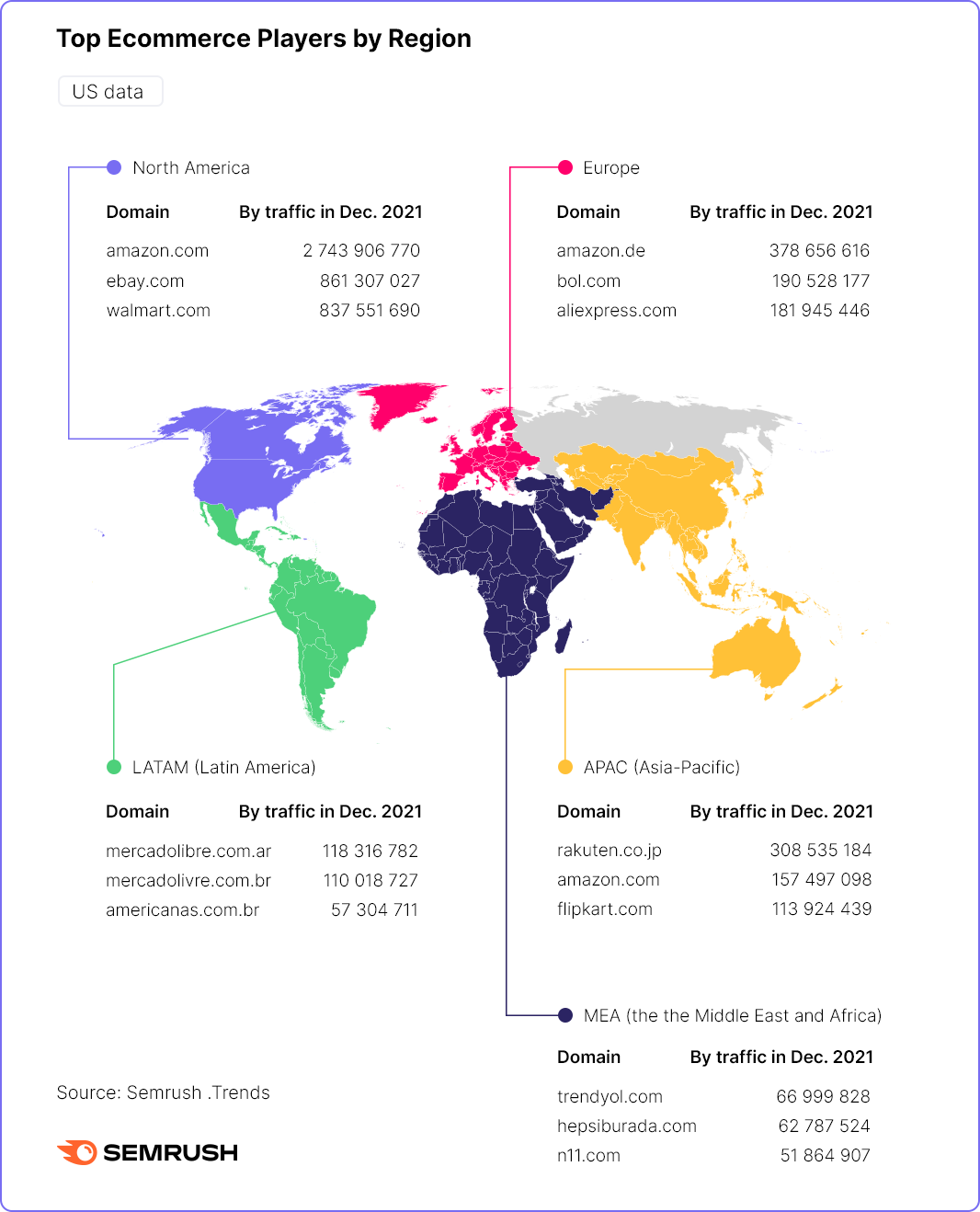
While major players like Amazon dominate the ecommerce market in almost every country, there are some regional nuances.
Amazon is the #1 ecommerce brand across North America and Europe. The latter’s top 3 features some Europe-local brands— the Netherlands-based Bol.com and Сhina-based Aliexpress.com.
The biggest differences to the global ecommerce picture occur within the non-western regions—MEA (the Middle East and Africa), LATAM (Latin America), and APAC (Asia-Pacific).
The MEA region’s top 3 brands are all Turkey-based—the country has seen one of the fastest growth trends, with the ecommerce boom more than doubling from 2017 to 2021 and reaching more than $22 billion in sales.
LATAM’s most popular e-tailers are also more local, with the Argentina-based MercadoLibre (MercadoLivre in Brazil) and Brazil-based Americanas making up the top.
APAC’s top features more familiar names like Rakuten and Flipkart—brands that are renowned on a global scale.
Ecommerce Industry: Are US Trends Any Different?
As the majority of online shoppers and top brands all come from the US, we’ve decided to see how the trends from the previous section vary for the top-performing ecommerce region.
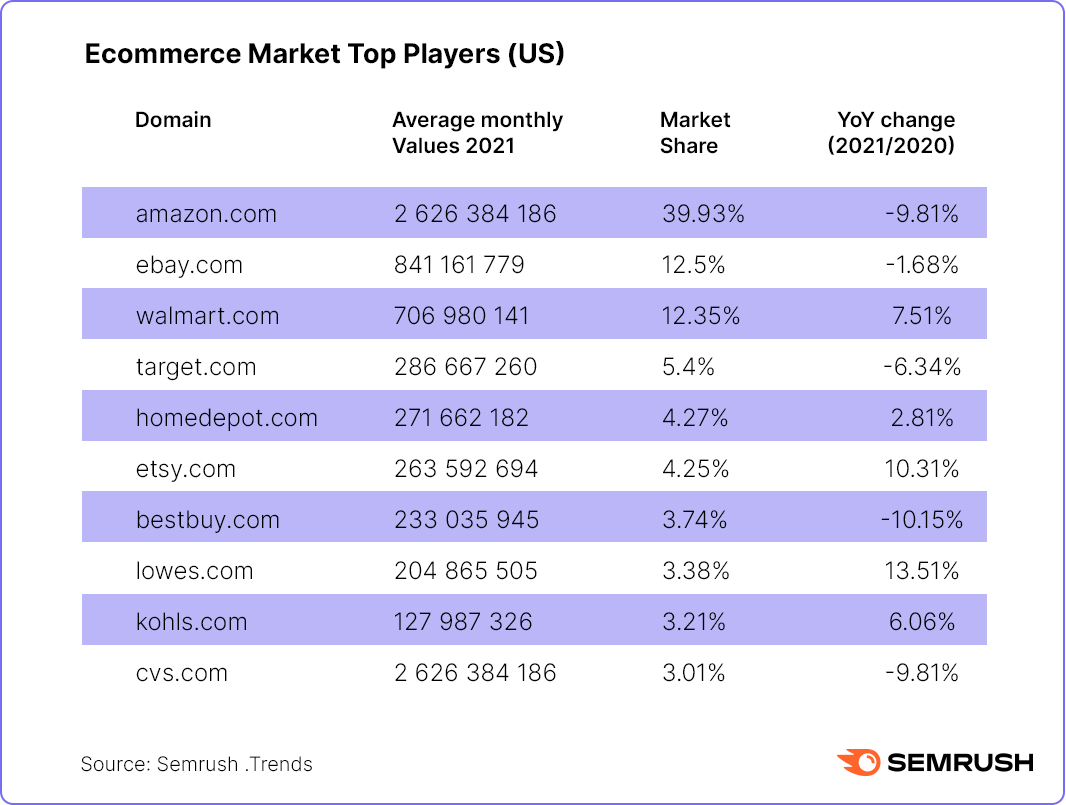
Similar to its worldwide position, Amazon holds the #1 spot across the most popular ecommerce sites in the US. The marketplace has a whopping 40% market share—more than its five closest competitors combined.
If we dig into the YoY market share trend, though, we can see that in 2021, the market leader has lost a significant part of the market, almost 10%. Among the top 3 market players, Walmart (+8%) was the only one to see its market share go up in 2021.
The fastest growth rates belong to the smaller competitors—Lowe’s (+14%) and Etsy (+10%).
In general, we’re seeing some mixed trends in the US—while some players are still capitalizing on the previous year’s ecommerce boom, others, and especially the bigger brands, are already seeing the effect of the market’s overall cooldown.
What does this mean: If you’re competing for the attention of the US audience, the race is only getting tougher. The smaller players grow while the big ones still hold a significant—even dominant in Amazon’s case—market share. With this in mind, you have to focus on competitive intel and create game-changing strategies that will help you break through the competition.
US Ecommerce Market Size (Dec 2020-Dec 2021)
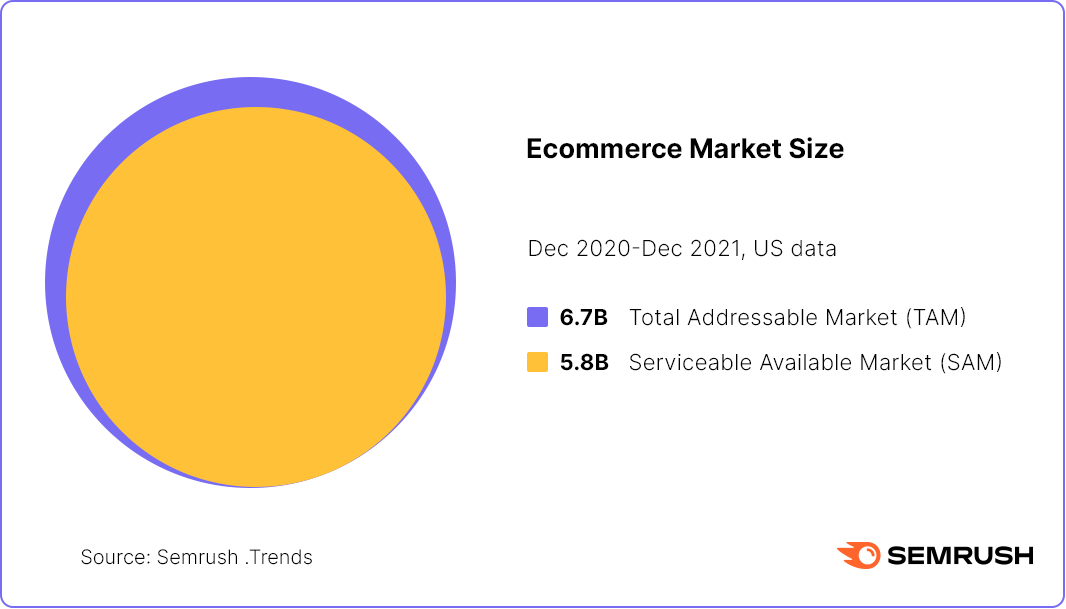
Any market has untapped growth potential. But most players don’t even know the size of the existing market. So we combined potential audiences for the top ecommerce players in the US to assess the market size for the country.
We looked at the demand stats for products the US e-tailers are offering (based on keyword volumes and traffic to these keywords) and topped this off with their actual audience. We discovered:
- The total addressable market (TAM) for ecommerce goods in the US is at 6.7 billion. This, of course, doesn’t mean that if you had a 100% market share, you’d get almost 7 billion visitors. This number implies that if you were to sell all the products available on the ecommerce market in the US, you could expect around 7 billion interest points in these products, not necessarily sales, though.
- The total serviceable market (SAM) in the US is at 5.8 billion. This number is more sales-focused and shows how many sales you can potentially see if you held a 100% market share within the ecommerce space in the US.
What does this mean: Certainly no one can have a 100% market share in any industry, but this number, especially if you look at it across time, gives a more realistic view of the online market size than actual traffic numbers, hinting exactly at the unrealized market potential.
Top US Ecommerce Players: Are Market Leaders Still in the Lead, and Who Has the Potential to Change the Game?
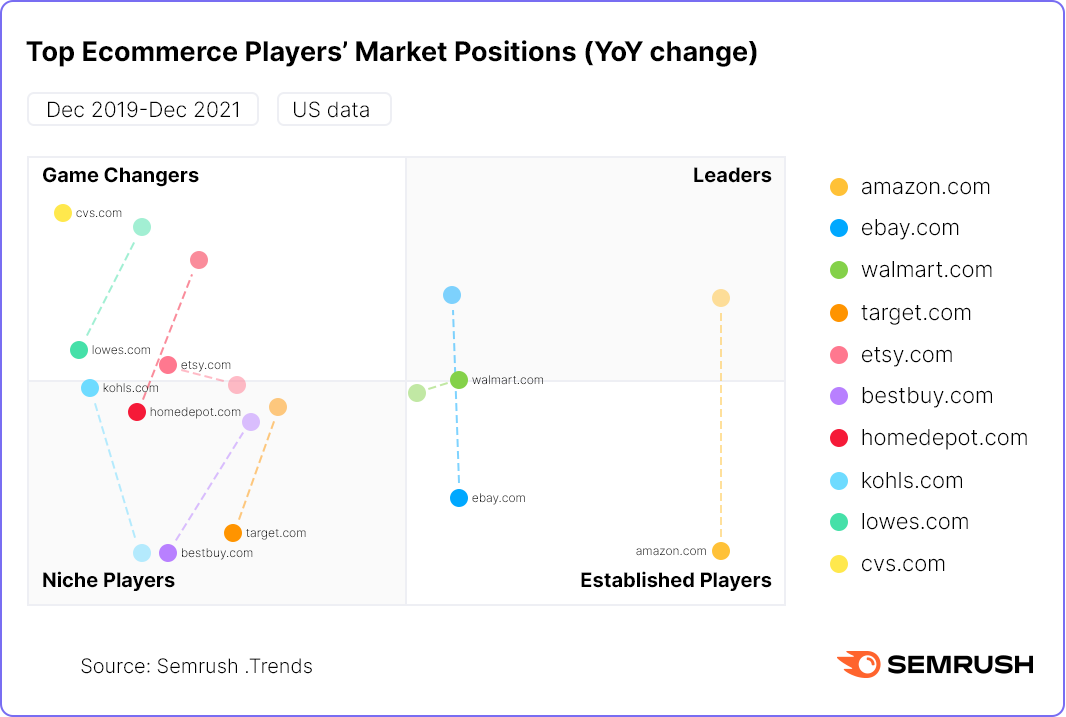
Moving away from an abstract view of the market to real figures, we’ll see that the ecommerce industry in the US was experiencing a lot of volatility throughout the past year:
- The overall slowdown of market growth left its mark on the key e-tailers’ market positions—half of all the leading ecommerce brands saw their positions weakening in 2021 compared to 2020.
- With no strong game-changers–aka brands that are seeing the fastest traffic growth rate but have lower traffic share–we see the majority of players sticking to the status quo. For instance, Kohl’s and Etsy lost their game-changer status and have become niche players. BestBuy and Target also dove even deeper into the niche player segment.
- The biggest shifts were seen within the Leaders and Established Players positions. Thanks to high traffic share and relatively high growth rate, Walmart is the only e-tailer that even competes for the Leader status in 2021. Amazon and eBay—2020’s Leaders—lost their positions in 2021 and are now among Established Players, or brands with large market shares but a slow growth pace.
How Do the Top Ecommerce Brands Generate Traffic?
As the US ecommerce players have always led the way when it comes to marketing strategies, we’ll dissect their most successful traffic acquisition strategies. But do the top US market players’ strategies differ from the global traffic generation trends?
Read on to see.
E-tailers’ Traffic Generation Strategy (Global)

When we look at the overall traffic acquisition patterns among the leading ecommerce brands worldwide, we can see that direct traffic dominated the entire industry.
This implies that brand awareness is the most powerful tool in ecommerce marketers’ toolbox. Direct traffic has always accounted for over 40% of traffic within the ecommerce space, and this trend only grew throughout the pandemic and has continued to grow since.
Paid and social traffic share has seen little to no change for the past few years, which means that changes come from elsewhere.
It seems search has given way to referral as the second most important traffic source for e-commerce sites, meaning that strong marketing partnerships and link-building efforts can go a long way as a future traffic acquisition strategy.
What does this mean: Ecommerce businesses have always relied on brand awareness, but in 2021 this is increasingly the case. So if you have to make choices when investing in marketing campaigns, give priority to brand awareness and partnerships that can bring referral traffic.
The Leading US Ecommerce Players’ Traffic Acquisition Strategies
To assess the US brands’ traffic generation tactics, we looked at the top three most popular e-tailers—Amazon, eBay, and Walmart.
The overall picture is similar to the global one—the three brands get the majority of their traffic from direct, and referral comes as the second most important traffic source.
But if we look at the YoY traffic breakdown for the three ecommerce sites, we’ll get a more nuanced view:
- Amazon, the US brand that lost the most market share in 2021, has seen a significant drop (-13%) in direct traffic. So if we consider brand awareness as the key traffic generation strategy for ecommerce sites, Amazon’s loss of traffic comes as no surprise. Amazon also saw a big decline in search (-23%) and paid (-8%) traffic, a pattern that goes along with the general industry trends.
- The same story is true for eBay, another market leader that saw its traffic go down in 2021. They saw a decrease in direct traffic (-10%), as well as paid and search channels, but realized growth in referral traffic (+17%). This probably saved the brand from losing a higher market share in the US.
- Now, Walmart, the only US brand that has both high market share and saw its traffic only go up, has been doing something right in 2021. Unlike the other two market leaders, all Walmart’s traffic sources brought in higher numbers of visitors, with the only exception being paid. Curiously, Walmart’s social traffic expanded by 24%, so it’s worth taking a look at its social media strategy for some inspiration.
What does this mean: It’s curious to see such a tight correlation between the industry’s best practices and changes in the actual channel-by-channel traffic breakdown for select e-tailers. As direct traffic appears to be the most valuable traffic source for the industry, those that lose some audience numbers from that channel are immediately showing slower growth rates.
Why People Turn to E-tailers: Most Wanted Products and Calls-to-Action
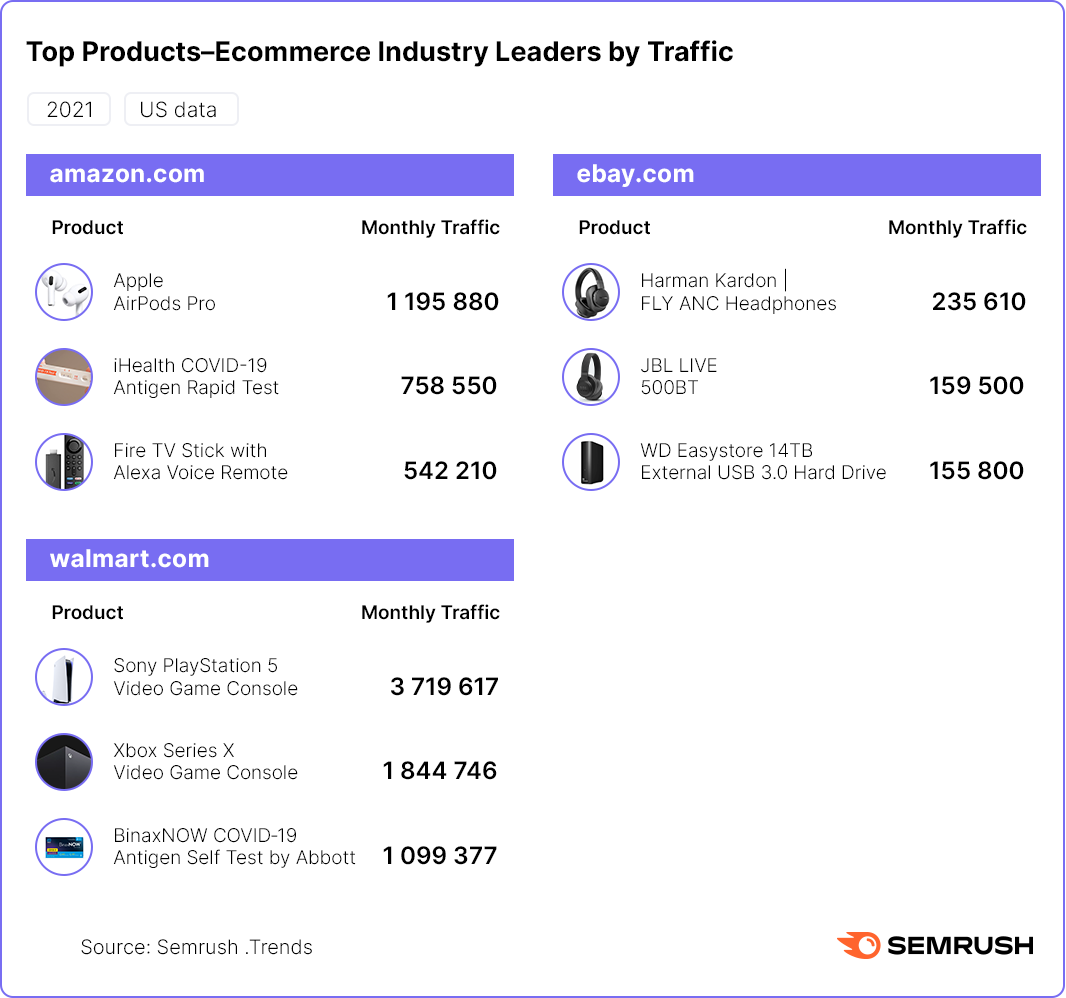
he leading question for any ecommerce business is, “What do customers want?” From country to country, people turn to e-commerce sites for various products. For the US, it’s mainly high-tech products that entice users to shop online:
- Amazon’s most popular pages are dedicated to AirPods and the Fire TV Stick with Alexa Voice Remote. Pandemic-related rapid tests for COVID were also top three.
- eBay’s visitors also love headphones, but prefer Harman Kardon and JBL.
- Shoppers who turn to Walmart appear to be most interested in all things gaming, with Sony PlayStation 5 and Xbox topping the most wanted list. Just to note, Sony’s console page attracts double the number of visitors compared to Xbox!
Amazon’s Most Popular Products in 2021
While the cumulative view of the most popular items for multiple e-tailers typically featured electronics and pandemic-related products, Amazon’s most trending internal searches were different.
Thanks to Sellzone Keyword Wizard tool, we could pinpoint which products people searched for the most on Amazon throughout 2021.
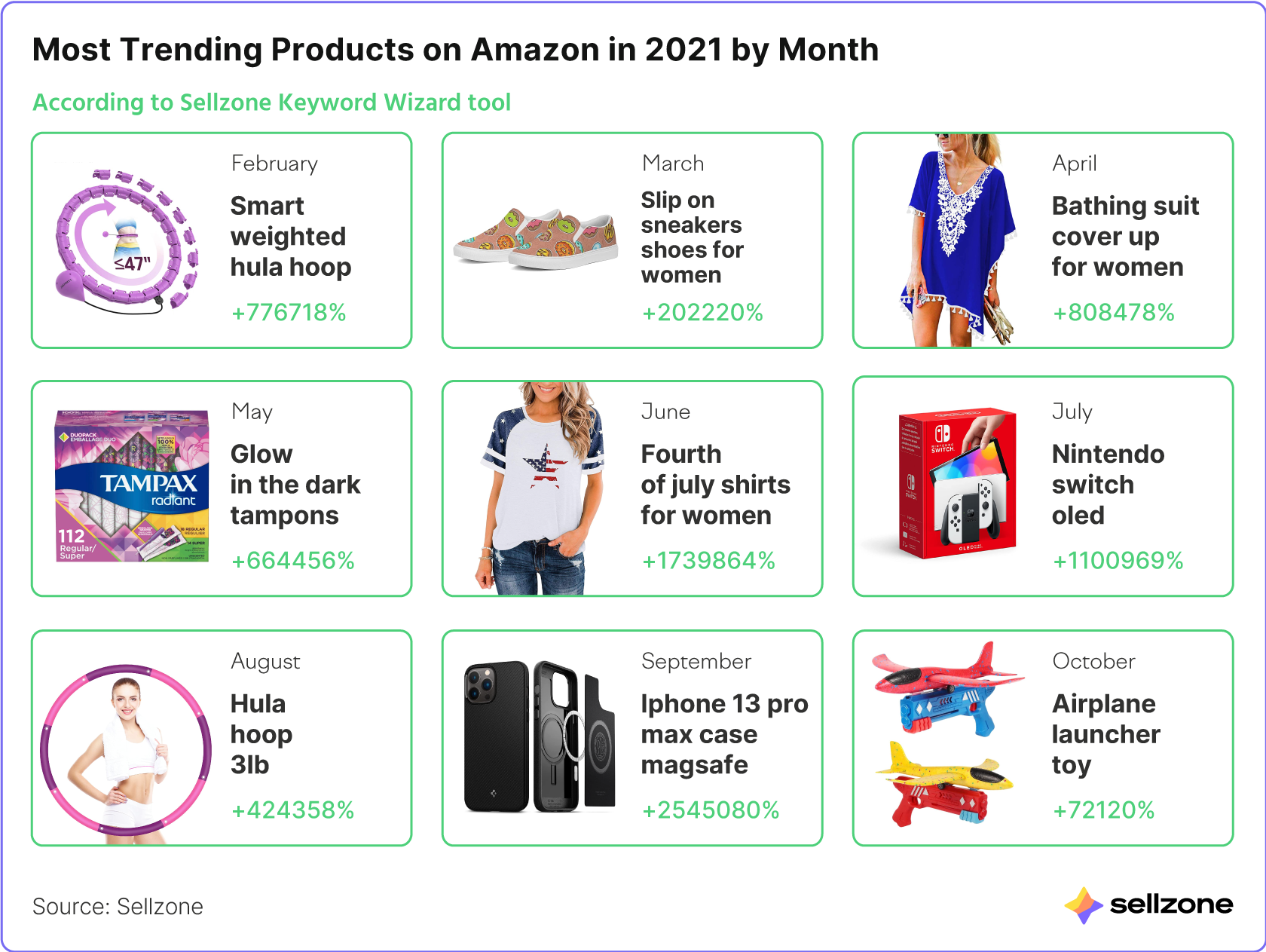
What Actually Makes Online Shoppers Click?
Each marketplace has its own triggers—words, or CTAs (calls-to-action), that entice surfers to click on the product ad and choose one platform over another.
We’ve analyzed hundreds of digital ads from the top 10 e-tailers in the US and pinpointed the most popular CTAs within their ad copies:
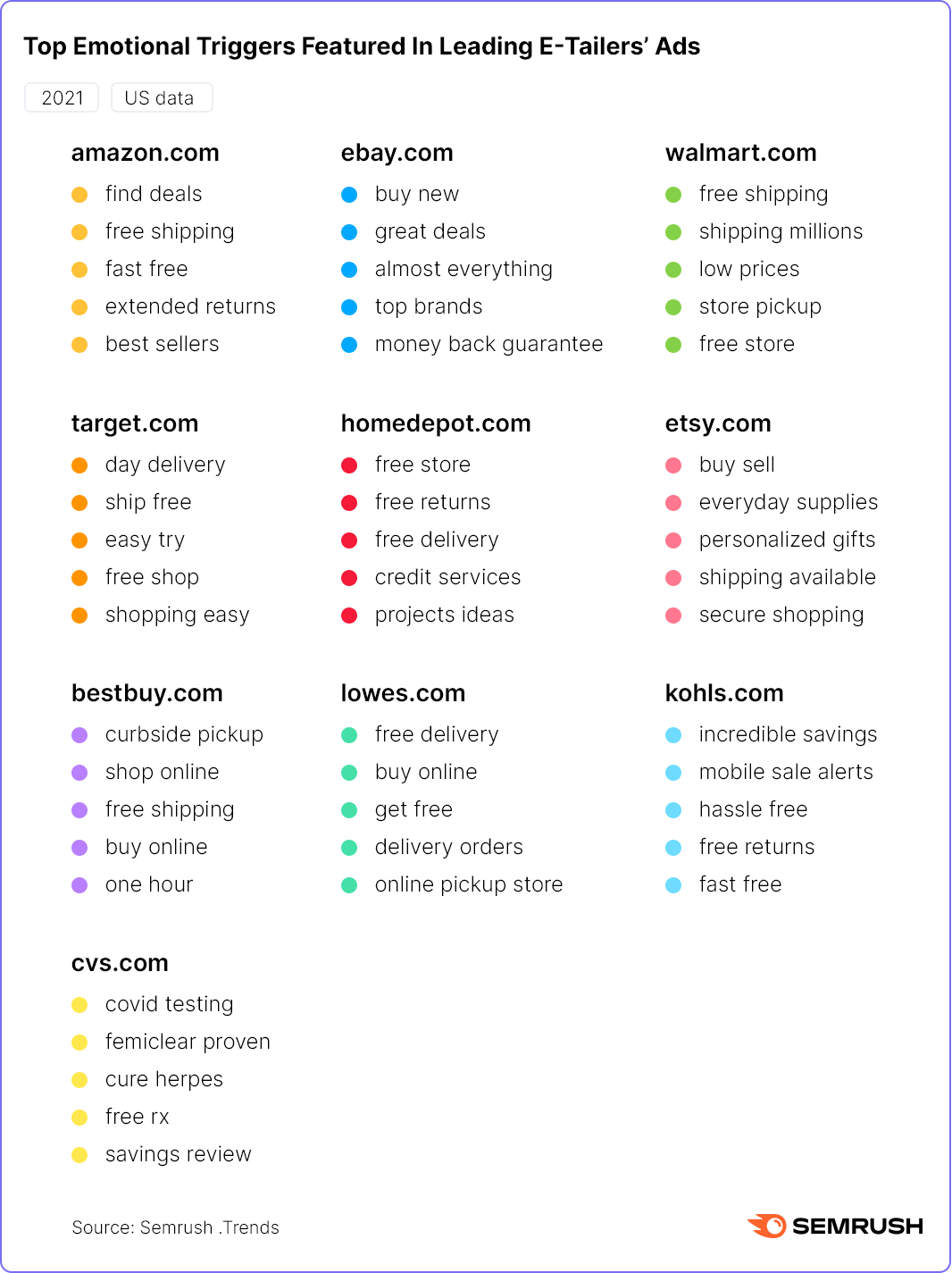
Words like “deal”, “free shipping”, and “free/easy returns” are present across most of the marketplaces’ ads. The key messaging is built around these three promises, with some nuances:
- Pharma-related e-tailers like CVS feature health-related CTAs, with COVID testing topping the list of most popular trigger words.
- Kohl’s often emphasizes its sale alert service and hassle-free online shopping.
- BestBuy often promises a one-hour delivery, which implies that the marketplace puts a bigger bet on the promptness of shipping. So does Target, only its offer has a more extended timeframe—one day.
- eBay appeals to customers by focusing on its offering of top brands.
- Etsy, unlike the rest of the e-tailers, underlines secure shopping.
Of course, we can’t claim that these messages are the most efficient, but if ecommerce businesses’ ads feature certain words repeatedly, it implies they work the most.
Insight-Driven Recommendations to Shaping Your 2022 Marketing Strategy for Ecommerce
A lot of ecommerce marketers thought that the pandemic-induced growth was here to stay. Pre-COVID forecasts also suggested that 2020 would be larger than 2019, and 2021 would be greater still.
But COVID reshuffled this steady growth and predictable market patterns, driving an incredible traffic surge to e-tailers throughout 2020. In 2021, however, as the offline world started its slow but steady reopening, market expansion slowed down and even got overturned.
This report tackled some of the key 2021 digital trends within the ecommerce industry specifically to help those who make the calls within the ecommerce space. So here are some of the most crucial points to take away for shaping your marketing strategy in the upcoming year:
2020’s ecommerce market expansion was promising an ever-growing audience base and, hence, lower competition. But the ecommerce boom has slowed down, so your marketing strategies should now target competitors and market share expansion.
- Desktop experiences also matter
As much as mobile still dominates the landscape, ecommerce sites attract a comparable share of desktop users. So cross-device optimization is the only way to go in order to offer a bump-free UX and UI experience to all users.
- Consider expanding your target market
While the English-speaking world is responsible for the largest traffic share for ecommerce sites, other geos can help you expand your overall market share and bring in an influx of new shoppers, hence, more sales, and, as a result, more cash flow to invest in more marketing campaigns.
France, Germany, and Japan have large audiences interested in online shopping, so you may want to embrace them before your competitors do.
- The US ecommerce market is getting harder to win
Bigger players are losing some chunk of their market share to smaller players. Looks like a promising trend, but you’ll have to compete against the biggest chips on the global ecommerce market—Amazon, eBay, and Walmart.
It seems like the only winning strategy here is to learn about the competition in and out and come up with strong creative strategies that will help you beat the stronger rivals.
- Prioritize brand awareness campaigns over everything else
The post-pandemic era of ecommerce is marked by the rise of direct traffic. And unlike many other trends that disappeared during 2021, this one appears to have stuck. So brand awareness campaigns are the key to helping you attract more visitors and expand your market share. Anything that brings you referral traffic—co-marketing campaigns, various partnerships, and link-building—should also be within your focus.
- Regularly check your premises
While we’ve tried to highlight ecommerce trends that are here to stay for the long haul, the industry changes very fast. So you’ll always be navigating uncharted waters and trying new things, new platforms, and new tactics. To do that successfully, you need all the insights you can get—from both the market and the competition. Semrush .Trends does just that.

